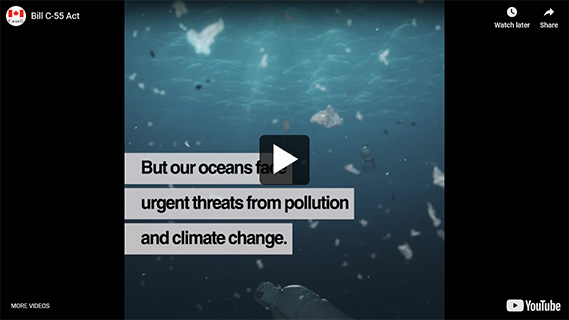Changes to the Oceans Act
As part of its plan to meet Canada’s marine conservation targets, the Minister of Fisheries, Oceans and the Canadian Coast Guard tabled Bill C-55, An Act to amend the Oceans Act and the Canada Petroleum Resources Act, in June 2017. Bill C-55 received Royal Assent on May 27, 2019.
On this page
| Previous Oceans Act | Oceans Act with Bill C-55 Amendments |
|---|---|
No protection is provided to an area identified for conservation until a Governor in Council (GIC) regulation is enacted. There is no limit on the length of time to establish an Oceans Act Marine Protected Area (MPA) through GIC regulation. |
Interim protection, through the use of a Ministerial Order, may be provided to an area identified for conservation. The MPA would be in force for up to five years during which the process to establish protection via a proposed permanent measure would continue. After the five years, the MPA would be repealed or replaced by a permanent measure, such as a GIC regulation. |
| There is no requirement to apply the precautionary principle when deciding to establish an Oceans Act MPA. | The Minister would be required to apply the precautionary principle when deciding to establish any Oceans Act MPA. |
| Enforcement powers and fines are not aligned with updated, current provisions in other legislation, such as the Environmental Enforcement Act. | Enforcement powers and fines are strengthened to align with updated, current provisions in other legislation, such as the Environmental Enforcement Act. |
The Oceans Act and associated Regulations governing Marine Protected Areas are available on the Department of Justice website, as is the Canada Petroleum Resources Act.
Two-Step Approach to Marine Protected Areas
The changes to the Oceans Act allow for the option to freeze the footprint of an area through Ministerial Order using a new Oceans Act authority. The changes maintain the designation of MPAs through GIC regulations.
The creation of an MPA via Ministerial Order may occur before a GIC regulation, but would not be a requirement. An MPA via Ministerial Order allows for interim protection of the area, where needed, via a new two-stage approach:
- Step 1: designate the MPA boundary and ‘freeze the footprint’ of ongoing activities in the area based on initial science and consultations via a Ministerial Order regulation;
- Step 2: further science, consultations, risk assessments, and socio-economic and ecological overviews would be conducted to develop a permanent measure, such as an MPA via GIC regulation, within five years of the MPA via Ministerial Order being established.
‘Freezing the Footprint’
Freezing the footprint means not increasing the allowed human activities beyond the ongoing activities in a marine area identified in the regulations for the MPA. Ongoing activities would continue and any new activities would be prohibited; some activities regulated under federal fisheries legislation or the Canada Petroleum Resources Act may be restricted further.
Ongoing Activities
An ‘ongoing activity’ is an activity which:
- Does not require an authorization, including a permit or licence, and has been carried out within one year before the MPA is established (e.g., kayaking, swimming, etc.);
OR - Requires an authorization, including a permit or licence, and has been carried out in the area within one year before the MPA is established (e.g. fishing, shipping, tourism activities, etc.);
OR - In those cases where the activity has not yet been carried out, but the activity is already authorized, including by permit or licence, to be carried out in the time period after the MPA is established, the activity is considered ongoing as long as the authorization was issued before the MPA is established.
The following activities would be allowed in MPAs:
- Any activity for the purposes of public safety, national defence, national security, law enforcement, or to respond to an emergency.
- Marine scientific research, compatible with the conservation objective of the interim marine protected area and with appropriate authorizations.
Updating Enforcement Provisions
Changes in the Bill also update and strengthen enforcement and offence provisions, including enforcement officer’s powers, in order to improve the Oceans Act’s consistency with the Environmental Enforcement Act and the Fisheries Act. Changes to other provisions include: compliance orders; offences and punishment (e.g., fines); proceedings against ships; and, increasing the limitation period to five years.
Precautionary Principle
The amendments improve the Minister and Governor in Council’s ability to implement the precautionary principle when designating new Oceans Act MPAs, which means that a lack of scientific certainty regarding the risks posed by activities would not be used as a reason to postpone the designation, or to not designate, an MPA.
Canada Petroleum Resources Act
The Minister of Natural Resources Canada (NRCan) and the Minister of Indigenous and Northern Affairs Canada (INAC) have statutory responsibilities for petroleum activities in Canada’s federal offshore lands that include the Pacific, Arctic, Hudson Bay and areas in the Atlantic that are not governed by federal-provincial Accord Acts. The Canada Petroleum Resources Act (CPRA) provides the Ministers with authority to regulate offshore oil and gas activities in these areas.
To complement the proposed amendments to the Oceans Act, the Government of Canada amended the CPRA. The proposed amendments would allow the Minister of NRCan or INAC to:
- Prohibit oil and gas activities in marine areas where an MPA via Ministerial Order is established while the regulation for an Oceans Act MPA is being developed;
- Cancel a company’s oil and gas interest in areas where Oceans Act MPAs are designated by federal government regulation; and
- Compensate for the cancellation of a company’s oil and gas interest impacted by the designation of an Oceans Act MPA should no other option be agreed upon.
- Date modified:
